In Central America, Climate Change Is Driving Families North
Extreme weather is forcing farmers and their families off their land
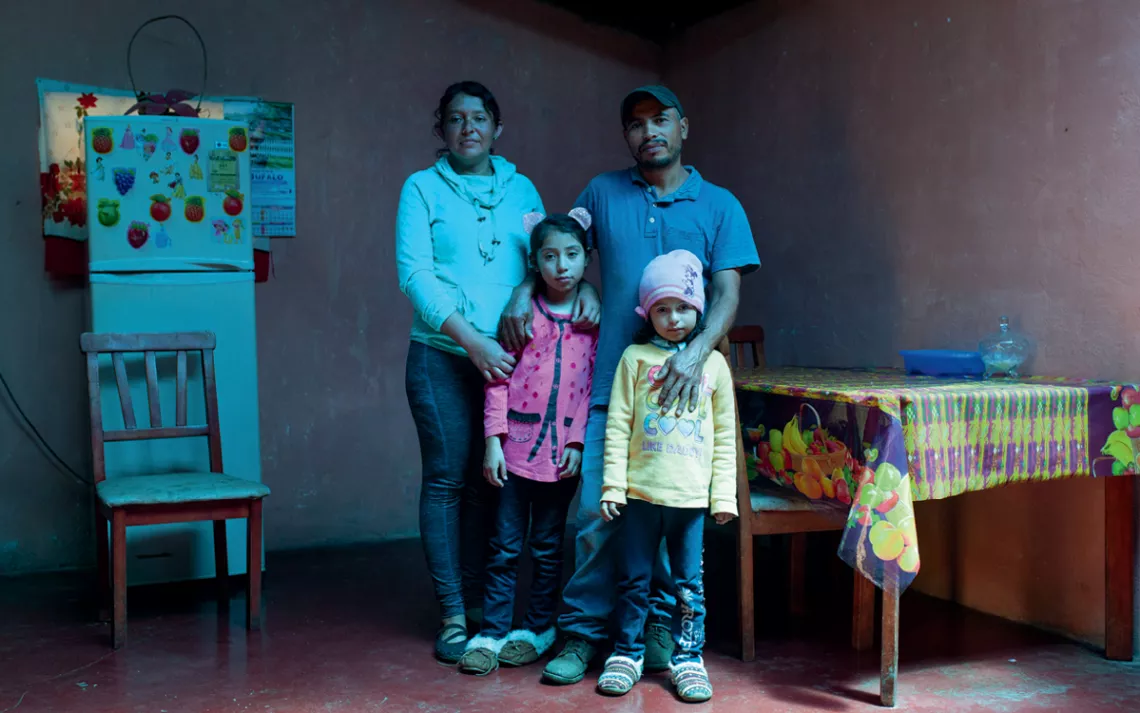
Photos and Video by James Rodríguez
AFTER THE SUN crept past its midday seat and started softening into the afternoon, five-year-old Jerlin Sayai Herrera Escobar liked to stand on the little lawn in front of her house, under the oak tree, and look at the town below. She’d scan the area for her sister among the students pouring out of the schoolhouse. Out they would come, giggling and teasing one another, walking toward their homes for lunch in twos and threes—their matching red sweaters glowing like wayward fruits among the fields.
Jerlin wasn’t old enough to go to school yet, but wherever else Yeni, her eight-year-old sister, went, Jerlin went with her. When people in town greeted them, Yeni would respond in her outgoing way and nudge her shy sister to do the same. Sometimes, Yeni would speak for both of them.
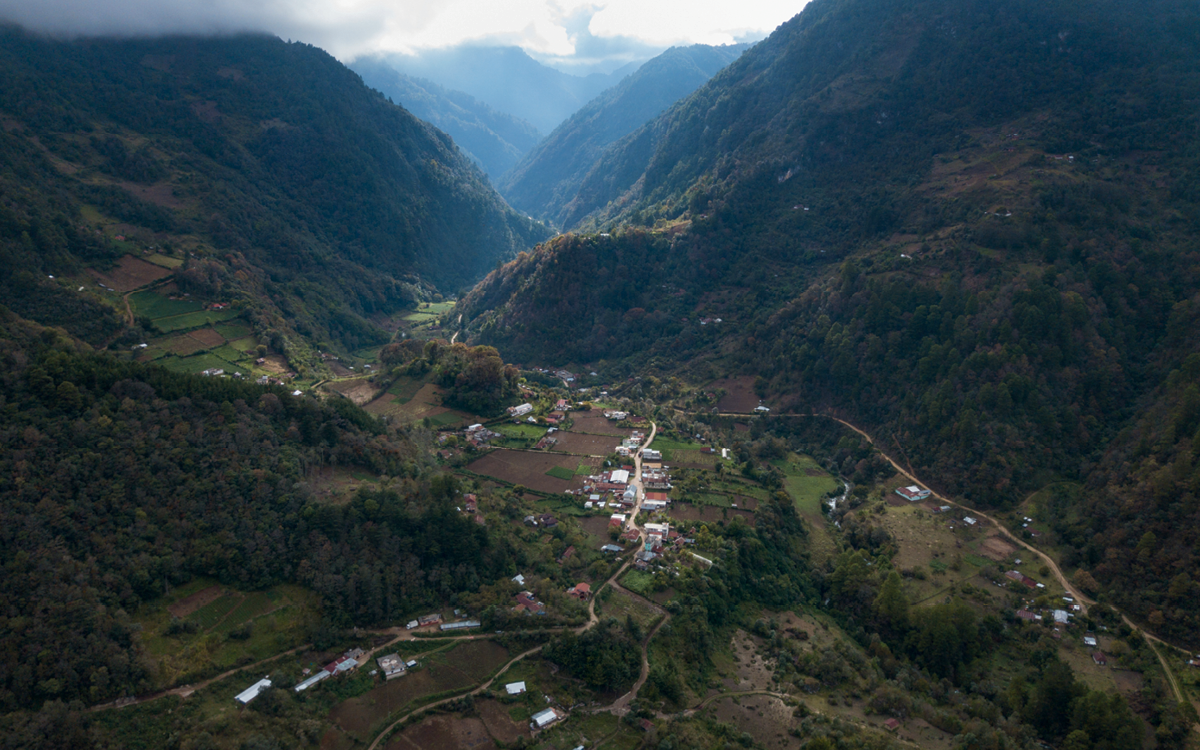
The village of San Francisco Las Flores, Guatemala.
In spring 2019, during the potato harvest, their parents started to worry. Since Jerlin and Yeni shared a bedroom with their parents, they could overhear whispered conversations about the family’s mounting debt and the growing exodus of neighbors from their town, San Francisco Las Flores—a little hamlet next to a stream that runs cold with the waters of the Sierra de los Cuchumatanes in western Guatemala. These neighbors were hoping to make a life in the north. Yeni got excited. She had always wanted to go to the United States and experience things she had only seen on television; she wanted to see snow and houses decorated with colorful lights during the holidays. She wanted to learn English; she wanted to get a bicycle that she could learn to ride. Jerlin, who shrank away from new things and took days to warm up to distant cousins, didn’t want to go. She wanted to stay home, where it was familiar.
Like almost everyone else in San Francisco Las Flores, Yeni and Jerlin’s father was a farmer. Just as his father had done before him, Max Ronaldo Herrera Figueroa, whom everyone knew as Ronny, planted potatoes during the dry season and corn during the rainy season—but it was getting more and more difficult to tell which season was which. In April 2019, it was time to harvest and sell potatoes to the traveling middlemen who would take the vegetables to distant markets, but the economics of potatoes seemed to be playing a joke on the farmers. The 40 quetzales (approximately $5.20) being offered for 220 pounds of potatoes was barely enough to cover the rising cost of growing them. After months of hard and nerve-racking toil, the farmers of San Francisco Las Flores wouldn’t make enough money to eat.
Faced with a burgeoning debt from their unsuccessful growing seasons, Ronny and his wife, Lleny Suleyma Escobar de Herrera, decided that their only real option was to go north and try their luck in the United States. The land that had sustained the family no longer seemed capable of supporting their hopes of a stable life for their daughters. Lleny had some chickens she could sell to gather a bit of money, and Ronny found someone to buy his horse. Their town was in the eastern mountains of Huehuetenango, a department in Guatemala that has one of the country’s highest rates of migration, and it wasn’t hard to find a coyote who would take them to the US-Mexico border.
The coyote they found charged 25,000 quetzales (approximately $3,250) for every parent-child duo, so Ronny and Lleny had to borrow enough to pay the 50,000 that would buy passage for everyone. They would leave eight days later.
In order to prepare Yeni and Jerlin for the journey, they had started giving the girls multivitamins in mid-spring. Ronny asked their local priest to pray for them. They agreed not to bring too many things, aside from a few changes of clothes. The girls were too young to carry their own backpacks anyway.
In early May, Ronny and Lleny set out with their daughters. Their little blue house with its corrugated roof was shuttered, and the peach tree wasn’t yet bearing fruit as they walked down the little gravel trail snaking into town. Ronny had grown up in San Francisco Las Flores, and his parents lived down a small hill from his house, their places connected alongside a livestock paddock by a narrow path occupied by a few goats. Family members who had moved away were still just a few hours down the road. Leaving wasn’t just a matter of departing from a place; it meant saying goodbye to everyone who made up the social fabric of their days—to Ronny’s brothers, who lent a hand in the fields when it was planting time; to Lleny’s mother-in-law, who prepared breakfast for the family to eat on the outside terrace; to Yeni and Jerlin’s aunt, with her roguish jokes.
When the family left before dawn, they didn’t know when they would ever see anyone again. It was 3 A.M. The coyote was waiting.
DURING THEIR MOMENT of crisis, Ronny and Lleny made the same decision that more and more families across Central America are making. Last year, the US Border Patrol arrested more people in the borderlands than at any time in the past decade. In 2011, 86 percent of people arrested trying to cross were from Mexico; in 2019, 81 percent were from Guatemala, Honduras, and El Salvador. Once, the migrants were mainly single adult men and women; now they frequently come with the entire family.
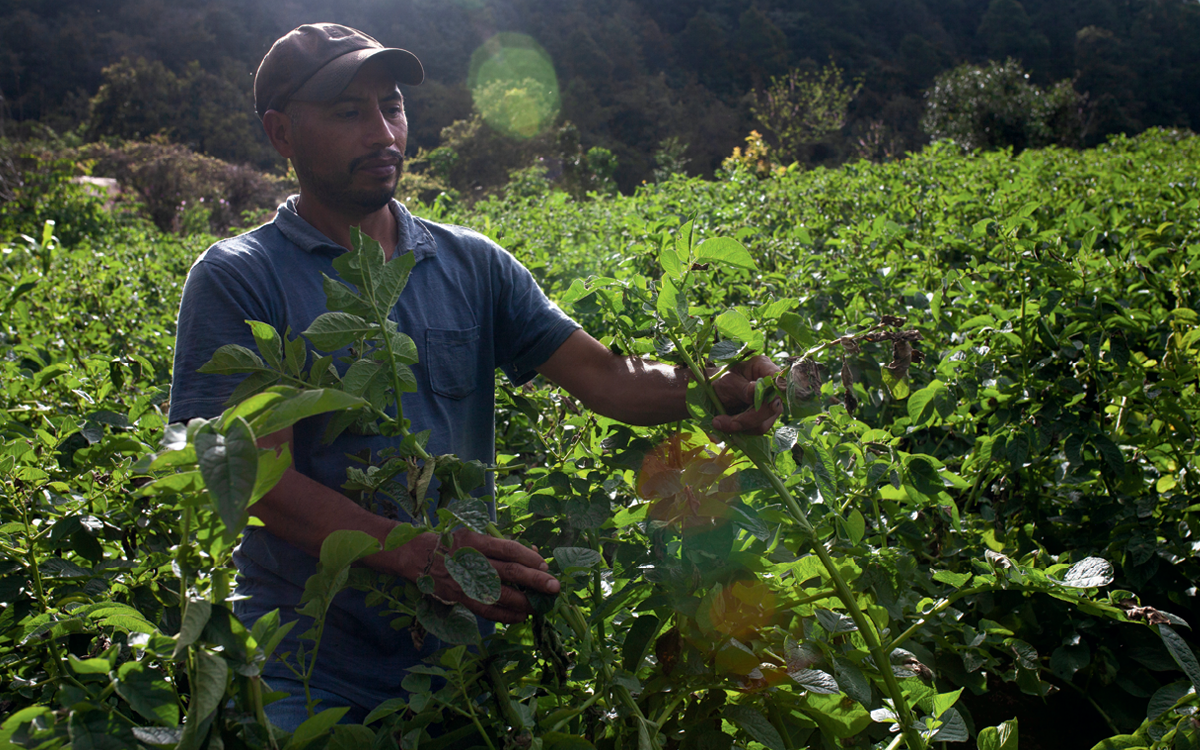
Max Ronaldo Herrera Figueroa in his potato field.
It is impossible to say what prompts each person to leave their home and everything they know behind. Violence certainly plays a role for some. El Salvador has the highest homicide rate in the world. Guatemala is considered to be one of the most corrupt countries in the world. It’s not just that people are killed; justice is absent.
But there are other reasons people are leaving, factors that are more complex but just as certain. Guatemala and El Salvador are ranked by researchers as among the countries most vulnerable to natural disasters, and Honduras is among those most affected by climate change. All three countries belong to what is known as the Dry Corridor, which has seen increasingly extreme droughts and erratic rainfall. Life across the region, especially for people who rely on the land, has become in many places almost unbearable.
In the Sierra de los Cuchumatanes, when the rains come, they come with a violence, in a sudden rush from an unpredictable sky, tearing through tree branches and disabling power lines. Just an hour up the hill from San Francisco Las Flores, the ground is rocky, and coniferous trees grow in stands among fields of boulders; people have to collect rainwater in cisterns and ration it throughout the year for cooking and washing. But in San Francisco Las Flores, with its icy sinew of a stream and hidden waterfalls, finding water isn’t as much of a problem. During the droughts that hit Guatemala, El Salvador, and Honduras between 2014 and 2018, leaving more than a million people hungry, the hamlet was spared from the worst of the dry spells.
On hot days in the valley, though, the sun beats down stronger than it used to. At every hour of the day, farmers make their way slowly through the fields with backpacks of pesticides strapped to their bodies, carefully spraying the potato plants. Less than a decade ago, hardly anyone used pesticides in San Francisco Las Flores. When Ronny’s father was a boy, no one in the valley used any chemicals at all to cultivate corn, beans, or potatoes. Now, the patriarch and his sons check constantly for signs of the growing number of pests that can wipe out their crops: whiteflies, black spots that rot the stems of potato plants, a worm that attacks young corn. Whenever something appears, they go to the local supplier of pesticides and fertilizers, knowing that each quetzal invested in keeping the plants alive is one less that they’ll pocket when the accounting is done at the end of the season.
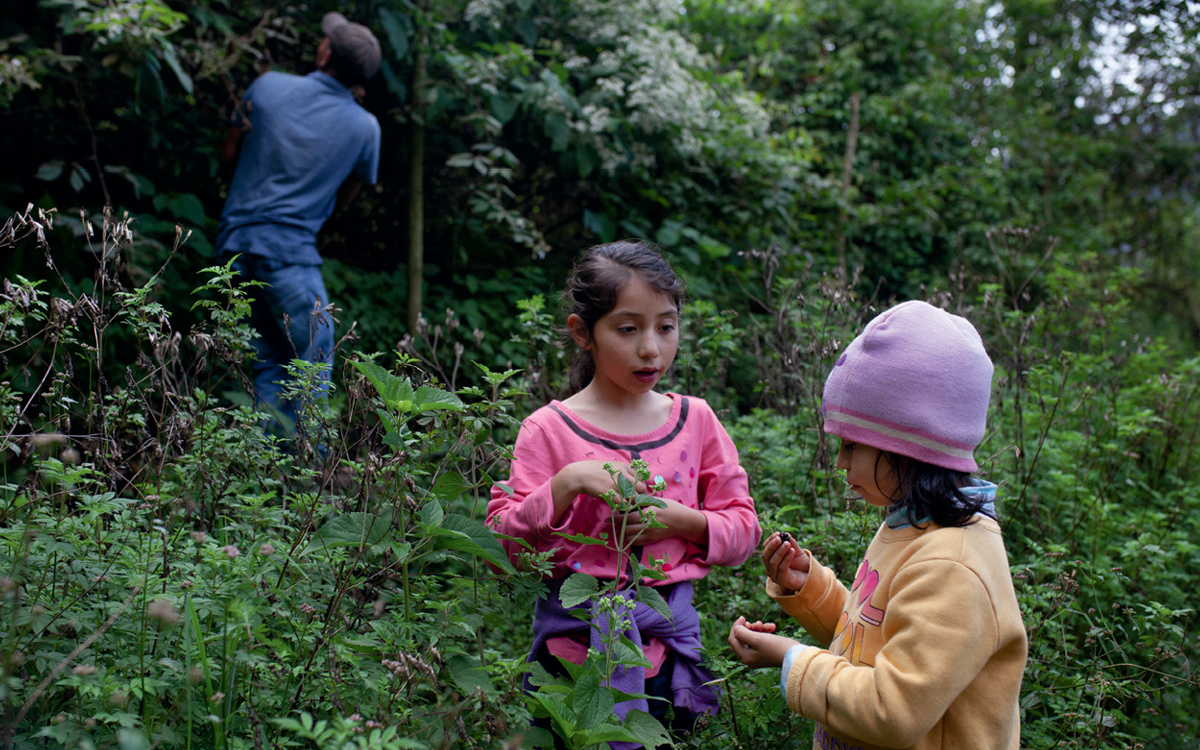
Yeni collects wild blackberries with her sister, Jerlin.
It is notoriously difficult to link small and gradual shifts in conditions in a particular village or valley to global changes caused by greenhouse gases in the atmosphere. A team of researchers from the University of Arizona recently set out to assess two of the most common events that people link to climate change in Central America: the terrible drought that has plagued the region for years and the erratic rainfall reported, especially by farmers. Using data from satellite imagery and local weather stations spanning more than 35 years, the researchers found that in the region, areas were affected differently based on a variety of local factors and climate complexities. But in some places, they found that the seasonal dry spells had lengthened—in a few instances significantly.
In extreme cases, farmers had had to wait up to 20 days longer than usual for the rainy season to begin again. In other areas, researchers found that even though overall rainfall hadn’t changed, it was coming in more concentrated, torrential bursts.
Climate models that take available data and project future scenarios based on both historic emissions and expectations for future emissions show that Central America will experience many more droughts by the end of the century. “A drying trend is one of the most robust conclusions from global climate change models in Central America,” says Talia Anderson, one of the University of Arizona researchers. “By the end of the century, we expect it to be much drier.” Most models predict moderate-to-severe droughts in the region, but higher temperatures will also make it more difficult for moisture to remain in the soil. In 2018, drought caused severe crop losses in the Dry Corridor, prompting El Salvador and Honduras to announce a state of emergency. The 2018 Intergovernmental Panel on Climate Change report also anticipated a higher risk of crop-destroying pests and diseases, like the ones Ronny and his family were seeing more of in their fields. Throughout the three countries affected, losses in bean and corn crops planted by subsistence farmers ranged from 75 to 100 percent.
In many cases, crop losses directly translate to hunger and malnutrition, especially for subsistence farmers. “Chronic malnutrition, which is when children eat but don’t eat the amount or quality that they should, affects cognitive development,” says Miguel Angel García Arias, Action Against Hunger’s regional director for Central America. “The places in Guatemala where we see the highest levels of chronic malnutrition, in the departments of San Marcos and Huehuetenango, is where children will be affected for their entire lives.”
These kinds of forces are expected to press more and more people to seek an alternative means of survival. Some estimates put the cumulative number of climate migrants from Central America and Mexico at 3.9 million by 2050. Data gathered by US Customs and Border Protection and published by NBC last year showed that many Guatemalans were leaving because of crop shortages and starvation linked to extreme poverty in the areas of the country most affected by climate change. According to NBC, the internal report was given to Homeland Security officials, but the White House, under President Donald Trump, ignored it.
PEOPLE IN TOWN still talk about the exodus of the past few years. At first, houses were boarded up as owners fled north, and school classrooms sat nearly empty. Now, in San Francisco Las Flores and across Huehuetenango, there is ceaseless construction, and almost every house reflects its owners’ aspirations of limitless improvement—a half-built garage, the beginnings of a second story.
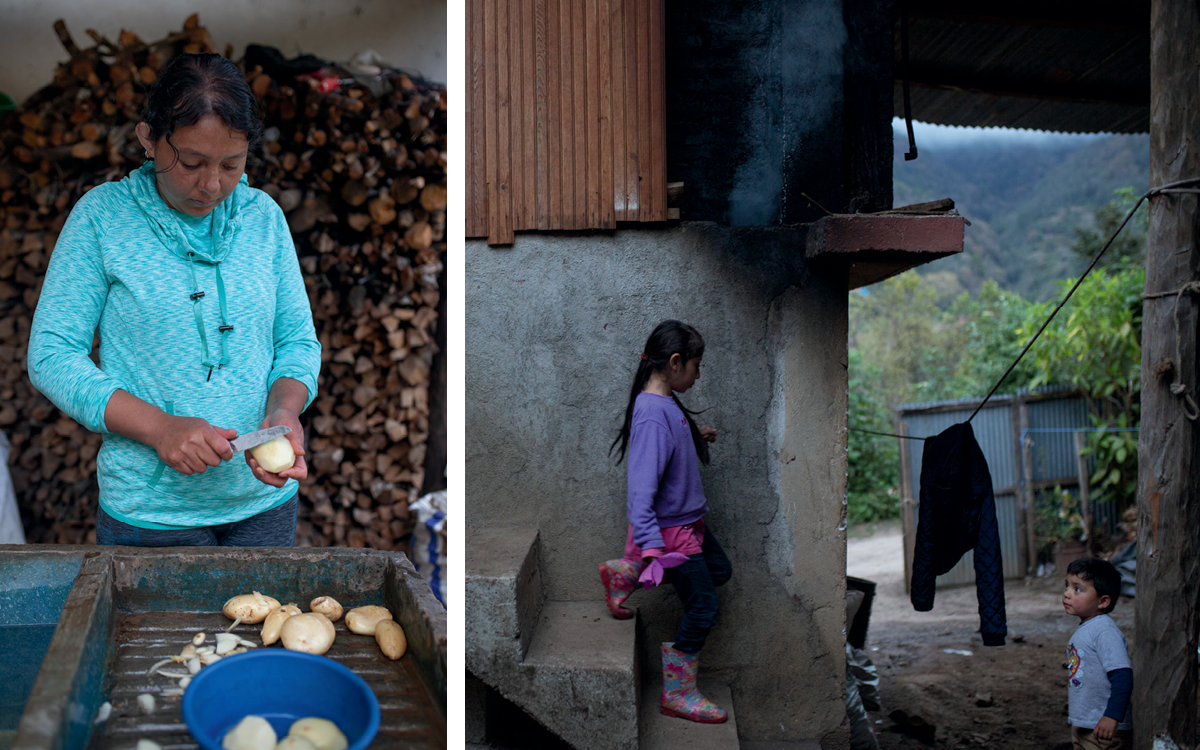
Left: Lleny Suleyma Escobar de Herrera at her home. Right: Yeni with her cousin at their grandparents’ house.
In many instances, the homeowners are absent, having left to work in the United States, which is why the homes are called remittance houses. Ronny’s own little blue house is the product of his years in the United States, where he traveled as a teenager escaping the Guatemalan civil war to work cutting cucumbers in Florida and picking blueberries in South Carolina before he found a job in a chicken factory in Alabama. He worked the graveyard shift there for four years, removing the left wing from chicken carcasses, and the repetitive movement permanently damaged the bone tissues in his wrists. He knew how hard life was for immigrants in the States, and he didn’t want to go back. But by last year, it was the only option left.
By the time they arrived at the US-Mexico border in mid-May 2019, just a few days after leaving their home, the Herrera Escobar family had been joined by other people also traveling with children. Their coyote had accompanied them on big buses that navigated through Mexico, paying off police and migration officials as they passed through the southern tropics and northern ranchlands. But when they reached the desert metropolis of Ciudad Juárez, spooned by a curve of the border across from the sunburned city of El Paso, Texas, their coyote left them at a safe house.
“It would be better for you two to cross separately, each with one of the children,” a man at the safe house told them. Otherwise, there was a risk that one of them could be put in charge of both children and the other deported.
They decided that Lleny would go first with Jerlin, and the two left that same night in a group with around 60 others. One of the local coyotes brought them to the border and warned them that they had to run so they wouldn’t be caught by Mexican migration authorities and sent back to Guatemala. They ran toward the border wall, and a few of the men climbed to the top and over; Lleny passed Jerlin up so that she would get to the other side.
A few Border Patrol agents arrived, and Lleny remembers them shouting in Spanish, “Go back to your countries. What are you doing here?” But the children were already on the US side, and so the parents ignored the agents and climbed over too.
Lleny spent two nights in Border Patrol tents with hundreds of others, shivering and wrapped around Jerlin. She filled out paperwork, and they were dropped off at a shelter in El Paso. She called a childhood friend in Tupelo, Mississippi, who helped pay for their flights and picked them up at the airport in Atlanta.
On the night of the crossing, Ronny and his daughter Yeni walked along the border wall with a handful of others until they found an opening underneath that they could slip through. Led by a coyote, they walked through the desert for a few hours before arriving at a house on the outskirts of El Paso. Ronny and Yeni were put in a little room with two other men and their children. There was one bed for them all to share, so the men slept on their jackets on the floor and let the kids share the mattress. The next day, the smugglers informed Ronny that the price of passage had gone up, and they wanted $8,000 now and another $8,000 later. They told a friend of his in Alabama that if he didn’t pay up, they would kill Yeni or Ronny, but the friend didn’t have the money.
For days, Ronny and Yeni stayed in the little house, where two American women watched over them. The women would monitor Ronny and Yeni every time one of them left the room to go to the bathroom. Occasionally, a few men would show up in a beat-up pickup truck to check on everything.
“Those are the real bad guys,” the women liked to tell Ronny and the others. To forestall escape attempts, the two women warned their hostages that they had guns in the house, but they spent most of the time smoking weed and taking some other drugs that Ronny couldn’t identify, even in the presence of their own children. Yeni could play with a few toys, but her father warned her not to get too close to one of the American children, who looked sick.
Eventually, he told her that they would have to escape. Yeni was afraid of the women, but she trusted her father. One afternoon, when the women were in the other room cooking, Ronny took a knife to the back-door lock. “Don’t make any noise, honey, or else they will catch us,” he told Yeni.
He had already warned her that they would have to run; once they were outside, they ran, Ronny holding on to Yeni’s hand tightly.
FOR MANY PEOPLE, the border is a place of nightmares. The first time Ronny crossed, he was one of five men who walked for days through the desert. Two of them collapsed on the journey, and he never saw them again.
Since the Trump administration’s Migrant Protection Protocols (MPP), also known as the Remain in Mexico program, went into effect in early 2019, the nightmare has gotten worse. Criminal groups like Los Zetas prey on migrants. Even before the policy was put into effect, people trying to cross were often kept in detention centers for weeks. One father from a town up the road from San Francisco Las Flores traveled to the States in 2018 with his then-eight-year-old son, and they were separated by the US Border Patrol. The father was deported to Guatemala, while his son was transferred to a detention center in New York, where he stayed for seven months before getting sent back to be reunited with his parents. The family blames the sadness they endured for a strange onslaught of unrelated illnesses that affected them during the time the boy was gone.
It was sadness, too, that overtook the Herrera Escobar family. When Ronny and Yeni escaped from the house where they had been held hostage, they ran through the afternoon sun for at least 15 minutes before spotting a church and ducking into it. Through a side door, they entered a large hall where some people were playing something that looked like bingo. A priest came up to Ronny and Yeni and asked how he could help. They explained their escape. “It’s all right,” the priest told them. “Those people can’t come here and take you away.” Just a few minutes later, though, the women who had held them captive appeared in a pickup truck, screaming at them to return. Ronny and the priest said that they had already called the Border Patrol, and the women fled, fearing they would be caught and charged with human trafficking.
With no money and afraid of being targeted again, Ronny turned his daughter and himself over to the Border Patrol. After a miserable night in what’s known as a hielera, or ice box, a US holding cell with unrelenting air conditioning, they were sent back to Ciudad Juárez, Mexico. “Let’s not give up,” Yeni told her father, over and over. She still wanted to reach the United States and be with her little sister again.
After a few weeks in a shelter, though, she got a stomach bug and stopped eating. She caught a terrible case of head lice, even though Ronny bought shampoo to keep them as clean as possible. Some kids in the shelter hogged the few toys and bullied other children who wanted to share, and Yeni began to have ringing headaches that felt like a colony of red ants had invaded her ears. Ronny saw how many people in the shelter had been going to court hearings in the United States for months and still weren’t any closer to gaining passage. Some data put the success rate for asylum applications under the MPP program at 0.1 percent.
When a Mexican nonprofit offered Ronny and Yeni a free ride back to Guatemala, they took it.
“They don’t let people have phones in the shelter, and so I didn’t know what had happened with my wife,” Ronny says. “I felt awful. I thought my wife was in the same situation as me, or possibly even that she was dead. Or . . . so many things go through your head, because you don’t know what’s going on.” He searched for Lleny in Ciudad Juárez, asking around discreetly and at the shelter office when he could, but he didn’t want to worry Yeni. He told her that her mother and little sister were fine, that they had reached the States safely.
In Tupelo, Lleny eventually found work at a factory, sewing couch cushions, and Jerlin went to daycare at the house of one of Lleny’s friend’s contacts. Once Ronny returned to Guatemala, he spoke to his wife often. Sometimes their conversations would end in tears. “We both cried, because of our sadness,” Ronny says. “Because I couldn’t cross the border, because I wasn’t with her. Because she wasn’t with me.”
When Yeni talked to her little sister over the phone, Jerlin would ask her, “When are you going to come so that we can play? I am waiting for you.” And Yeni would tell her that they were going to arrive soon, even though she knew it wasn’t true. “When you heard them talk over the phone, it was sad,” the girls’ aunt, Anira Mileisi Herrera Figueroa, says. “The older sister would ask how it was, what [Jerlin] liked, what she did. The little one would say, ‘Oh, there are so many mosquitoes here,’ things like that.” The two girls, having been together their entire lives, didn’t know how to be apart.
When Jerlin went to daycare, she would play for a few hours and then spend the entire afternoon with her backpack on, waiting at the front door to be picked up. Yeni, who had always been so talkative, spent days inside watching videos on her aunt’s phone. At night, she would cry for her mother. By October, Jerlin had stopped eating and begun to have nosebleeds. Lleny took her to a doctor, who told her that the girl had probably just eaten something bad, but Lleny knew what it really was. “She didn’t want to eat because she was sad,” Lleny says. “‘Eat!’ I would tell her, but she would say, ‘No, I don’t want to. I want to be with my sister.’”
After Lleny had worked enough to pay off the debt the family owed to the first coyote, she and Ronny decided they couldn’t keep the girls separated any longer. “I wanted her to stay, to go to her assigned court date and see what the migration officials had to say,” Ronny says. “But the girls got sick.” Ronny eventually resigned himself to the thought that their fates would rely on what their small patch of earth could provide. The heat of the sun and the betrayal of the rains, the plagues of insects—these were not things that were under his control.
A FEW DAYS AFTER Christmas, Lleny and Jerlin took a flight down to Guatemala City and traveled the pitted roads up to San Francisco Las Flores. Reunited, the girls started eating again, and Jerlin’s nosebleeds went away. When the potato plants were reaching waist height, Ronny went to the town of Huehuetenango with the hope of negotiating better prices for his potatoes with the association of merchants who bought them. He still didn’t know how the family was going to survive or whether he and Lleny would be able to provide for their daughters. Some of the potato merchants came to the meeting, in big cowboy hats and shiny boots, but the entire association needed to be there to negotiate, and the rest never showed up.
Soon, the peach tree was in bloom, and Ronny was back in his fields planting corn along a rocky slope. In each seed pit where he sowed the kernels, he dropped a little insecticide, to try to protect the seedlings as they sprouted into an unpredictable world.
This article appeared in the September/October 2020 edition with the headline "Toward the Desert."
 The Magazine of The Sierra Club
The Magazine of The Sierra Club



